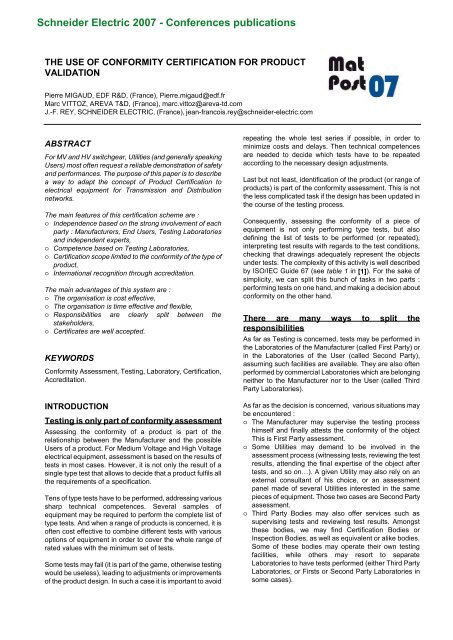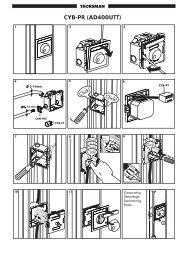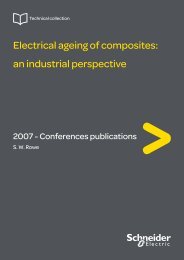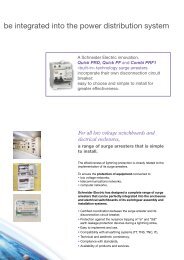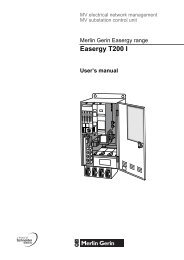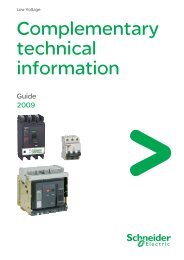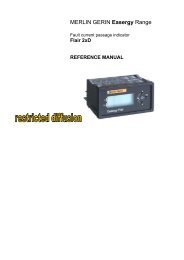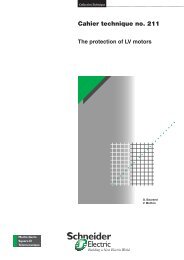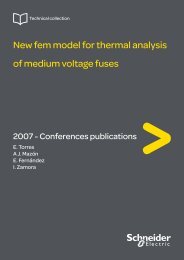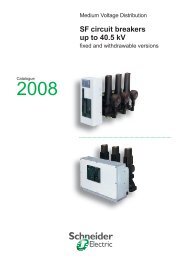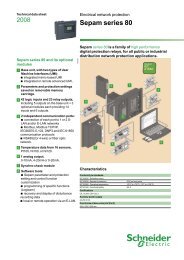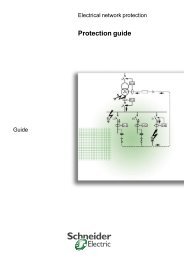The use of conformity certification for product ... - Schneider Electric
The use of conformity certification for product ... - Schneider Electric
The use of conformity certification for product ... - Schneider Electric
You also want an ePaper? Increase the reach of your titles
YUMPU automatically turns print PDFs into web optimized ePapers that Google loves.
<strong>Schneider</strong> <strong>Electric</strong> 2007 - Conferences publications<br />
THE USE OF CONFORMITY CERTIFICATION FOR PRODUCT<br />
VALIDATION<br />
Pierre MIGAUD, EDF R&D, (France), Pierre.migaud@edf.fr<br />
Marc VITTOZ, AREVA T&D, (France), marc.vittoz@areva-td.com<br />
J.-F. REY, SCHNEIDER ELECTRIC, (France), jean-francois.rey@schneider-electric.com<br />
ABSTRACT<br />
For MV and HV switchgear, Utilities (and generally speaking<br />
Users) most <strong>of</strong>ten request a reliable demonstration <strong>of</strong> safety<br />
and per<strong>for</strong>mances. <strong>The</strong> purpose <strong>of</strong> this paper is to describe<br />
a way to adapt the concept <strong>of</strong> Product Certification to<br />
electrical equipment <strong>for</strong> Transmission and Distribution<br />
networks.<br />
<strong>The</strong> main features <strong>of</strong> this <strong>certification</strong> scheme are :<br />
o Independence based on the strong involvement <strong>of</strong> each<br />
party : Manufacturers, End Users, Testing Laboratories<br />
and independent experts,<br />
o Competence based on Testing Laboratories,<br />
o Certification scope limited to the <strong>con<strong>for</strong>mity</strong> <strong>of</strong> the type <strong>of</strong><br />
<strong>product</strong>,<br />
o International recognition through accreditation.<br />
<strong>The</strong> main advantages <strong>of</strong> this system are :<br />
o <strong>The</strong> organisation is cost effective,<br />
o <strong>The</strong> organisation is time effective and flexible,<br />
o Responsibilities are clearly split between the<br />
stakeholders,<br />
o Certificates are well accepted.<br />
KEYWORDS<br />
Con<strong>for</strong>mity Assessment, Testing, Laboratory, Certification,<br />
Accreditation.<br />
INTRODUCTION<br />
Testing is only part <strong>of</strong> <strong>con<strong>for</strong>mity</strong> assessment<br />
Assessing the <strong>con<strong>for</strong>mity</strong> <strong>of</strong> a <strong>product</strong> is part <strong>of</strong> the<br />
relationship between the Manufacturer and the possible<br />
Users <strong>of</strong> a <strong>product</strong>. For Medium Voltage and High Voltage<br />
electrical equipment, assessment is based on the results <strong>of</strong><br />
tests in most cases. However, it is not only the result <strong>of</strong> a<br />
single type test that allows to decide that a <strong>product</strong> fulfils all<br />
the requirements <strong>of</strong> a specification.<br />
Tens <strong>of</strong> type tests have to be per<strong>for</strong>med, addressing various<br />
sharp technical competences. Several samples <strong>of</strong><br />
equipment may be required to per<strong>for</strong>m the complete list <strong>of</strong><br />
type tests. And when a range <strong>of</strong> <strong>product</strong>s is concerned, it is<br />
<strong>of</strong>ten cost effective to combine different tests with various<br />
options <strong>of</strong> equipment in order to cover the whole range <strong>of</strong><br />
rated values with the minimum set <strong>of</strong> tests.<br />
Some tests may fail (it is part <strong>of</strong> the game, otherwise testing<br />
would be <strong>use</strong>less), leading to adjustments or improvements<br />
<strong>of</strong> the <strong>product</strong> design. In such a case it is important to avoid<br />
repeating the whole test series if possible, in order to<br />
minimize costs and delays. <strong>The</strong>n technical competences<br />
are needed to decide which tests have to be repeated<br />
according to the necessary design adjustments.<br />
Last but not least, identification <strong>of</strong> the <strong>product</strong> (or range <strong>of</strong><br />
<strong>product</strong>s) is part <strong>of</strong> the <strong>con<strong>for</strong>mity</strong> assessment. This is not<br />
the less complicated task if the design has been updated in<br />
the course <strong>of</strong> the testing process.<br />
Consequently, assessing the <strong>con<strong>for</strong>mity</strong> <strong>of</strong> a piece <strong>of</strong><br />
equipment is not only per<strong>for</strong>ming type tests, but also<br />
defining the list <strong>of</strong> tests to be per<strong>for</strong>med (or repeated),<br />
interpreting test results with regards to the test conditions,<br />
checking that drawings adequately represent the objects<br />
under tests. <strong>The</strong> complexity <strong>of</strong> this activity is well described<br />
by ISO/IEC Guide 67 (see table 1 in [1]). For the sake <strong>of</strong><br />
simplicity, we can split this bunch <strong>of</strong> tasks in two parts :<br />
per<strong>for</strong>ming tests on one hand, and making a decision about<br />
<strong>con<strong>for</strong>mity</strong> on the other hand.<br />
<strong>The</strong>re are many ways to split the<br />
responsibilities<br />
As far as Testing is concerned, tests may be per<strong>for</strong>med in<br />
the Laboratories <strong>of</strong> the Manufacturer (called First Party) or<br />
in the Laboratories <strong>of</strong> the User (called Second Party),<br />
assuming such facilities are available. <strong>The</strong>y are also <strong>of</strong>ten<br />
per<strong>for</strong>med by commercial Laboratories which are belonging<br />
neither to the Manufacturer nor to the User (called Third<br />
Party Laboratories).<br />
As far as the decision is concerned, various situations may<br />
be encountered :<br />
o <strong>The</strong> Manufacturer may supervise the testing process<br />
himself and finally attests the <strong>con<strong>for</strong>mity</strong> <strong>of</strong> the object<br />
This is First Party assessment.<br />
o Some Utilities may demand to be involved in the<br />
assessment process (witnessing tests, reviewing the test<br />
results, attending the final expertise <strong>of</strong> the object after<br />
tests, and so on…). A given Utility may also rely on an<br />
external consultant <strong>of</strong> his choice, or an assessment<br />
panel made <strong>of</strong> several Utilities interested in the same<br />
pieces <strong>of</strong> equipment. Those two cases are Second Party<br />
assessment.<br />
o Third Party Bodies may also <strong>of</strong>fer services such as<br />
supervising tests and reviewing test results. Amongst<br />
these bodies, we may find Certification Bodies or<br />
Inspection Bodies, as well as equivalent or alike bodies.<br />
Some <strong>of</strong> these bodies may operate their own testing<br />
facilities, while others may resort to separate<br />
Laboratories to have tests per<strong>for</strong>med (either Third Party<br />
Laboratories, or Firsts or Second Party Laboratories in<br />
some cases).


